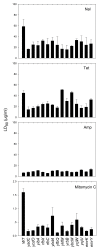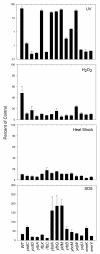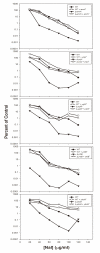Escherichia coli genes that reduce the lethal effects of stress
- PMID: 20128927
- PMCID: PMC2824699
- DOI: 10.1186/1471-2180-10-35
Escherichia coli genes that reduce the lethal effects of stress
Abstract
Background: The continuing emergence of antimicrobial resistance requires the development of new compounds and/or enhancers of existing compounds. Genes that protect against the lethal effects of antibiotic stress are potential targets of enhancers. To distinguish such genes from those involved in drug uptake and efflux, a new susceptibility screen is required.
Results: Transposon (Tn5)-mediated mutagenesis was used to create a library of Escherichia coli mutants that was screened for hypersensitivity to the lethal action of quinolones and counter-screened to have wild-type bacteriostatic susceptibility. Mutants with this novel "hyperlethal" phenotype were found. The phenotype was transferable to other E. coli strains by P1-mediated transduction, and for a subset of the mutants the phenotype was complemented by the corresponding wild-type gene cloned into a plasmid. Thus, the inactivation of these genes was responsible for hyperlethality. Nucleotide sequence analysis identified 14 genes, mostly of unknown function, as potential factors protecting from lethal effects of stress. The 14 mutants were killed more readily than wild-type cells by mitomycin C and hydrogen peroxide; nine were also more readily killed by UV irradiation, and several exhibited increased susceptibility to killing by sodium dodecyl sulfate. No mutant was more readily killed by high temperature.
Conclusions: A new screening strategy identified a diverse set of E. coli genes involved in the response to lethal antimicrobial and environmental stress, with some genes being involved in the response to multiple stressors. The gene set, which differed from sets previously identified with bacteriostatic assays, provides an entry point for obtaining small-molecule enhancers that will affect multiple antimicrobial agents.
Figures



Similar articles
-
The role of Escherichia coli YrbB in the lethal action of quinolones.J Antimicrob Chemother. 2011 Feb;66(2):323-31. doi: 10.1093/jac/dkq427. Epub 2010 Nov 23. J Antimicrob Chemother. 2011. PMID: 21098540
-
Identification and characterization of hydrogen peroxide-sensitive mutants of Escherichia coli: genes that require OxyR for expression.J Bacteriol. 1997 Jan;179(2):330-8. doi: 10.1128/jb.179.2.330-338.1997. J Bacteriol. 1997. PMID: 8990283 Free PMC article.
-
Genetic analysis of the requirements for SOS induction by nalidixic acid in Escherichia coli.Gene. 2005 Aug 15;356:69-76. doi: 10.1016/j.gene.2005.04.029. Gene. 2005. PMID: 16005583 Free PMC article.
-
Phenotypic characterization of overexpression or deletion of the Escherichia coli crcA, cspE and crcB genes.Microbiology (Reading). 2003 Aug;149(Pt 8):2107-2117. doi: 10.1099/mic.0.26363-0. Microbiology (Reading). 2003. PMID: 12904550
-
How killed enterobacterial cultures can activate living organisms to resist lethal agents or conditions.Sci Prog. 2003;86(Pt 3):157-78. doi: 10.3184/003685003783238662. Sci Prog. 2003. PMID: 15079995 Free PMC article. Review.
Cited by
-
Key evolutionary events in the emergence of a globally disseminated, carbapenem resistant clone in the Escherichia coli ST410 lineage.Commun Biol. 2019 Aug 29;2:322. doi: 10.1038/s42003-019-0569-1. eCollection 2019. Commun Biol. 2019. PMID: 31482141 Free PMC article.
-
The MFS efflux pump EmrKY contributes to the survival of Shigella within macrophages.Sci Rep. 2019 Feb 27;9(1):2906. doi: 10.1038/s41598-019-39749-3. Sci Rep. 2019. PMID: 30814604 Free PMC article.
-
Comparative proteomic analysis of Lactobacillus plantarum for the identification of key proteins in bile tolerance.BMC Microbiol. 2011 Mar 29;11:63. doi: 10.1186/1471-2180-11-63. BMC Microbiol. 2011. PMID: 21447177 Free PMC article.
-
Unraveling the functions of uncharacterized transcription factors in Escherichia coli using ChIP-exo.Nucleic Acids Res. 2021 Sep 27;49(17):9696-9710. doi: 10.1093/nar/gkab735. Nucleic Acids Res. 2021. PMID: 34428301 Free PMC article.
-
The serum resistome of a globally disseminated multidrug resistant uropathogenic Escherichia coli clone.PLoS Genet. 2013;9(10):e1003834. doi: 10.1371/journal.pgen.1003834. Epub 2013 Oct 3. PLoS Genet. 2013. PMID: 24098145 Free PMC article.
References
Publication types
MeSH terms
Substances
Grants and funding
LinkOut - more resources
Full Text Sources
Medical
Molecular Biology Databases
Research Materials

